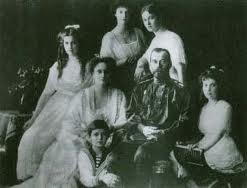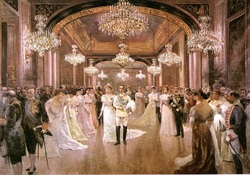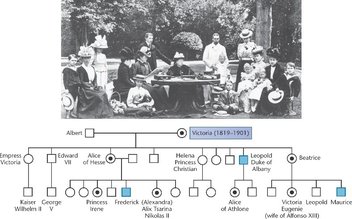Hemophilia: “The Royal Disease”

Until recently, hemophilia was untreatable, and only a few hemophiliacs survived to reproductive age because any small cut or internal hemorrhaging after even a minor bruise were fatal. Now hemophilia is treated with blood transfusions and infusions of a blood derived substance known as anti-hemophiliac factor.
Hemophilia has been called “The Royal Disease” and “The Disease of Kings” due to its prominent role in modern European history. Queen Victoria, who was Queen of England from 1837 to 1901, was a carrier and passed the gene down to several of her children. Two daughters, Alice and Beatrice, were carriers and her hemophiliac son Leopold had children before dying. Between all the descendants, hemophilia was passed on to the Spanish, German and Russian royal families.
Arguably one of the most famous people with hemophilia in history was the Russian Tsarevich Alexei, son of Nicholas, the Tsar of Russia in the early 1900s, and Queen Victoria’s granddaughter Alexandra.
While the European royals may be at the heart of the most well-known events in the history of hemophilia, there are other examples:
- The Talmud, a collection of Rabbinic teachings from the second century, exempts male babies from circumcision if two brothers had already died from the procedure. In addition, it noted that the baby boys needed to come from the same mother irrespective of the father. Later, it was also recognized that if a sister’s baby bled to death, that would also be considered in the decision regarding circumcision; hence the recognition that it was a sex-linked disorder.
- 12th century Arab physician Albucasis wrote about a family of men who died from bleeding after minor injuries.
- In 1803 Dr. John Conrad Otto, a Philadelphia doctor, wrote about hemophilia, determining it was hereditary and affected males. In his research he traced it back three generations to a woman who lived near Plymouth, New Hampshire, in 1720.
Hemophilia figured prominently in the history of European royalty in the 19th and 20th centuries. Britain's Queen Victoria, through two of her five daughters (Princess Alice and Princess Beatrice), passed the mutation to various royal houses across the continent, including the royal families of Spain, Germany and Russia. Victoria's son Prince Leopold, Duke of Albany suffered from the disease. For this reason, hemophilia was once popularly called "the royal disease".
The sex-linked X chromosome disorder manifests almost entirely in males, although the gene for the disorder is located on the X chromosome and may be inherited from either mother or father. Expression of the disorder is much more common in males than in females. This is because, although the trait is recessive, males only inherit one X chromosome, from their mothers, thus if the hemophilia gene is transmitted on it, there is no possibility for the male to inherit a hemophilia-free gene from his father to mask or dilute the symptoms. By contrast, a female who inherits a gene for hemophilia on one of her X chromosomes will also have inherited a second X chromosome from the other parent which is likely to carry a hemophilia-free gene that would prevent full expression of symptoms.
Ena brought hemophilia into the Spanish royal family.

May 31, 1906 - Wedding of Alfonso XIII of Spain and Victoria Eugenie of Battenberg
Victoria Eugenie, known as Ena, was a granddaughter of Queen Victoria and daughter of Princess Beatrice and Prince Henry of Battenberg. Ena brought hemophilia into the Spanish royal family. Alfonso and Ena are the grandparents of the present king of Spain, Juan Carlos. Their wedding was the last royal wedding in Madrid prior to the wedding of Crown Prince Felipe, their great grandson, and Letizia Ortiz.
en.wikipedia.org/wiki/Alfonso_XIII
en.wikipedia.org/wiki/Princess_Victoria_Eugenie_of_Battenberg
Victoria Eugenie, known as Ena, was a granddaughter of Queen Victoria and daughter of Princess Beatrice and Prince Henry of Battenberg. Ena brought hemophilia into the Spanish royal family. Alfonso and Ena are the grandparents of the present king of Spain, Juan Carlos. Their wedding was the last royal wedding in Madrid prior to the wedding of Crown Prince Felipe, their great grandson, and Letizia Ortiz.
en.wikipedia.org/wiki/Alfonso_XIII
en.wikipedia.org/wiki/Princess_Victoria_Eugenie_of_Battenberg

